
Alcatraz Reopening: Why Trump Seeks to Revive Prison
The Surprising Announcement of Alcatraz Reopening
In a move that’s shaking up national discussions, President Donald Trump unveiled his bold plan for Alcatraz reopening as a maximum-security federal prison on May 4, 2025. Through a fiery post on Truth Social, he directed key federal agencies like the Bureau of Prisons, Department of Justice, FBI, and Homeland Security to revitalize the historic island in San Francisco Bay, transforming it from a beloved tourist spot into a fortress for America’s most dangerous criminals. Have you ever wondered how a symbol of the past could become a flashpoint for today’s politics?
Trump’s declaration—”REBUILD, AND OPEN ALCATRAZ!”—paints this as a direct response to rising crime concerns, aiming to house violent offenders in a “significantly enlarged and renovated” facility. It’s a stark contrast to Alcatraz’s current role, where it draws over a million visitors each year as part of the Golden Gate National Recreation Area. This Alcatraz reopening proposal isn’t just about bricks and bars; it’s a statement on law and order that echoes Trump’s broader agenda, potentially reshaping how we view punishment in modern America.
Critics are already buzzing, questioning if this is more than a symbolic gesture. Yet, for Trump, it’s about reclaiming a piece of history to tackle what he calls “the dregs of society.” If this plan moves forward, it could redefine Alcatraz’s legacy, turning it back into the escape-proof stronghold it once was.
Exploring the Rich History Behind Alcatraz Reopening
To grasp why Alcatraz reopening is stirring such debate, let’s dive into the island’s fascinating backstory. Originally spotted by Spanish explorer Juan Manuel de Ayala in 1775 and dubbed “La Isla de los Alcatraces” for its pelican population, this 22-acre rock in San Francisco Bay has worn many hats over the centuries.
Alcatraz’s evolution from a natural wonder to a symbol of incarceration is a wild ride. During its early days, it served military purposes, but over time, it became synonymous with high-stakes imprisonment. Think about it: What if we could learn from history to avoid repeating its mistakes?
From Military Fort to Early Alcatraz Reopening Roots
The U.S. Army claimed Alcatraz in 1850 amid the California Gold Rush, turning it into a fortified outpost with cannons and the West Coast’s first lighthouse. Though it never saw battle, it quickly shifted to holding military prisoners by the late 1850s. By 1907, it was officially the Pacific Branch of the United States Military Prison, with new structures built to handle tougher inmates.
This phase highlights why Alcatraz reopening feels so intriguing—it’s not the first time the island adapted to society’s needs. Fast forward, and we’re seeing echoes of that transformation in Trump’s vision, raising questions about whether history is truly repeating itself or if we’ve learned from past errors.
The Golden Era of Alcatraz as a Federal Penitentiary
In 1933, the Department of Justice took over, launching Alcatraz as a federal penitentiary aimed at corralling the era’s most notorious criminals. The idea was straightforward: Create a “escape-proof” spot to show the public that the government meant business against the crime waves of the 1920s and 1930s. It operated for 29 years, housing legends like Al Capone, George “Machine Gun” Kelly, and Robert Stroud, the so-called “Birdman of Alcatraz.”
With its icy waters and remote location, Alcatraz became a symbol of unbreakable justice, though that didn’t stop 36 escape attempts—eight prisoners died trying, and five took their own lives. The most famous? The 1962 breakout by three inmates, whose fate remains a mystery. Now, as we discuss Alcatraz reopening, it’s worth asking: Could modern security make it even more formidable, or are we romanticizing a flawed system?
Life After Closure in the Alcatraz Reopening Debate
By 1963, Alcatraz shut down due to skyrocketing costs and deterioration, never quite filling its 336-inmate capacity. It then became a stage for Native American activists in the late 1960s and, since 1972, a popular museum under the National Park Service. Today, this shift underscores the tension in the Alcatraz reopening plan—balancing historical preservation with Trump’s push for a new purpose.
Trump’s Vision for Alcatraz Reopening: A Push for Law and Order
At its core, Trump’s Alcatraz reopening initiative ties into his tough-on-crime stance, framing it as a beacon of “Law, Order, and JUSTICE.” In his Truth Social post, he lambasted repeat offenders as societal burdens, vowing to use the island for the nation’s most violent threats. It’s a move that aligns with his policies, like expanding the death penalty and boosting police powers.
This isn’t isolated; Trump’s approach includes targeting specific groups, such as transgender inmates, and pushing mass deportations that have drawn fire for sidestepping legal processes. Imagine a world where Alcatraz once again stands as a deterrent—what might that mean for communities grappling with crime? By reviving this site, Trump aims to send a clear message, but at what cost to civil liberties?
His plan also echoes recent actions, like establishing a Guantanamo Bay facility for “egregious criminal aliens.” As Alcatraz reopening gains traction, it’s becoming a rallying point for supporters and a red flag for opponents, highlighting the ongoing debate over justice in America.
Practical Hurdles and Opposition to Alcatraz Reopening
While Trump’s enthusiasm for Alcatraz reopening is palpable, the road ahead is riddled with obstacles. From funding woes to political pushback, turning this idea into reality won’t be straightforward.
Jurisdictional Challenges in the Alcatraz Reopening Effort
Right now, Alcatraz is managed by the National Park Service, making any shift a jurisdictional nightmare. The Bureau of Prisons has pledged to follow Trump’s orders, but how do you repurpose a national treasure without disrupting its current role? Reports from sources like Axios indicate that infrastructure issues and staffing shortages in federal prisons could complicate things further.
Funding remains a big unknown—experts estimate massive renovations for water, electricity, and structural fixes, yet the White House hasn’t detailed costs. This Alcatraz reopening push might symbolize resolve, but practicalities could derail it, leaving us to ponder if the price tag is worth the spectacle.
Why History Might Doom Alcatraz Reopening
Alcatraz closed in 1963 for good reasons: It was too expensive and decaying. Back then, officials deemed it cheaper to build elsewhere than maintain the island’s harsh environment. Today, those same factors loom large, with potential billions needed for upgrades to meet modern standards.
It’s a cautionary tale—Trump’s plan overlooks how isolation drove up costs originally. As we explore Alcatraz reopening, one question stands out: Are we prepared to repeat history’s mistakes, or can innovation make it viable this time?
Political Resistance to Alcatraz Reopening
Figures like House Speaker Nancy Pelosi have already dismissed the idea as unserious, and local leaders in California are gearing up to fight. The island’s tourism value—generating millions for the economy—makes it a non-starter for many. If Alcatraz reopening proceeds, it could spark legal battles that test federal versus state authority.
The Wider Implications of Trump’s Alcatraz Reopening Plan
Beyond the island, Alcatraz reopening fits into Trump’s larger narrative on criminal justice and immigration. His administration’s deportation tactics and comments about sending citizens abroad have fueled accusations of overreach. A recent discussion with El Salvador’s president even hinted at extreme measures, adding layers to this proposal.
This approach raises ethical questions: How far should we go in the name of security? For everyday folks, Alcatraz reopening might symbolize protection, but critics see it as eroding rights. It’s a reminder that policies like this don’t exist in a vacuum—they affect real lives and communities.
What’s Next for Alcatraz in This Reopening Saga?
Looking ahead, the fate of Alcatraz hangs in the balance as agencies respond to Trump’s directive. Its role as a historical site and tourist draw complicates any changes, with over a million annual visitors underscoring its cultural value. Could Alcatraz reopening coexist with education, or would it overshadow everything?
Consider a hypothetical: What if we preserved the site’s history while adapting it for modern use? That might offer a balanced path, blending tourism with security in a way that honors the past.
Wrapping Up: The Contested Symbol of Alcatraz Reopening
In the end, Trump’s vision for Alcatraz reopening is more than a policy—it’s a statement about justice in flux. From its days as a military fort to a potential high-security prison, the island has always mirrored society’s shifts. As debates rage on, one thing’s clear: This could be a pivotal moment or just another headline.
If you’re intrigued by how history and politics collide, share your thoughts in the comments below. What do you think about bringing Alcatraz back? Explore more on our site for related stories, and consider subscribing for updates on evolving justice issues.
References
- Time Magazine. “Trump’s Plan to Rebuild Alcatraz as a Prison.” time.com/7282551/
- Axios. “Trump Orders Agencies to Reopen Alcatraz.” axios.com/2025/05/05/
- Bureau of Prisons. “History of Alcatraz.” bop.gov/about/history/
- Britannica. “Alcatraz.” britannica.com/topic/
- NBC Bay Area. “The Uncertain Future of Alcatraz.” nbcbayarea.com/news/local/
- NBC Washington. “Trump’s Order on Alcatraz.” nbcwashington.com/news/local/
- Travelsphere. “The History of Alcatraz.” travelsphere.co.uk/inspirations/
- SF Standard. “Trump Wants Alcatraz as Prison Again.” sfstandard.com/2025/05/04/






